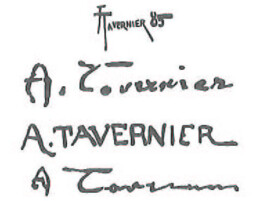
Tavernier Andrea *
TAVERNIER ANDREA
Torino 1856 – Grottaferrata (Roma) 1932
Studiò all’Accademia Albertina di Torino, dove ottenne premi scolastici fra il 1882 e il 1885; dal maestro A. Gastaldi derivò il solido disegno e il forte cromatismo. Nel 1884 esordì all’Esposizione Nazionale torinese con Rugiade primaverili e fu presente con assiduità alle mostre della Promotrice e del Circolo degli Artisti fino al 1923. Il realismo dei quadri di figura e dei ritratti di questo periodo appare condotto con attento studio degli effetti luminosi. Nel 1890 fu a Roma dove lavorò a vedute della città e della campagna (Cam-pagna romana, Torino, Galleria Civica d’Arte Moderna). Fu poi prevalente il suo interesse per il paesaggio alpino, studiato dal vero insieme a temi legati ai costumi valligiani (Finita la messa- Zoldo Alto, 1897, Torino, Galleria Civica d’Arte Moderna; Ultime gocce-Druogno, esposto a Torino nel 1898, Roma, Galleria Nazionale d’Arte Moderna). Cercò anche soggetti d’ispirazione sulla riviera adriatica e in Abruzzo, schiarendo la tavolozza e, dai primi anni del secolo, accogliendo motivi e modi simbolisti (Gli effimeri, trittico, esposto alla Biennale di Venezia nel 1903). Dopo il 1909 si trasferì a vivere e a lavorare nelle vicinanze di Roma.
